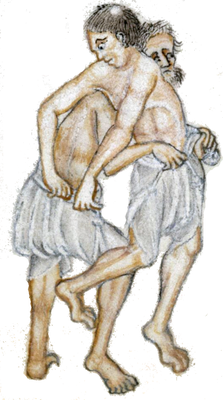 Wrestling
Wrestling
Wrestling is a popular pursuit up and down the coast, and Moru Kel is no exception: the people of Moru Kel enjoy watching many sports, but wrestling is chief among them.
Every Purdi closes with a bout in honor of Purnoz, the Festival of Fire highlights the city’s finest wrestlers, and Grenna brings bouts between up-and-coming youth wrestlers. Wrestling is also a common pastime in more relaxed settings, both as simple sport at local gatherings and as a way of settling barroom disputes without resorting to violence.
In recent decades, the Nawabe presence in the city has put its own unique stamp on the sport.
Wrestlers may not be armored. Generally serious athletes prefer to wear nothing but a small cloth at the loin, to make grappling more difficult. The use of ochala oil to slicken the skin is commonplace. Impromptu unorganized matches often lack specialized garments, and participants must make do with their trousers or gathered robes.
Striking of the opponent is generally forbidden, but tripping by sweeping of the un-grasped legs is permitted. Choking, gouging, and strangling are strictly prohibited.
Participants continue until one yields or a shoulder blade touches the ground, which loses the match. Having superior position when the match goes to the ground is very important: matches often begin tentatively, probing for weakness, reach a crescendo as they engage and fight to force the opponent to the ground in inferior position, and then move more slowly toward an inexorable pin. Occasionally, though, a wrestler with a strong ground game can reverse a positional deficit and win a match that appeared desperate when the match first left its feet. Such matches are among the most exciting and memorable, often talked about for years afterward.
Nawabean Wrestling
The style of wrestling in Nawabe is quite different: no sweeping is allowed, and a participant loses the match if any portion of their body other than their lower legs (from the knee down) or lower arms (from the elbow down) touches the ground. They tend to be faster paced, with none of the ground aspects of Urek-style wrestling. Consequently this less-subtle style has become popular with the youth of the city, who lack the patience to appreciate the skill involved in true wrestling. Still, some credit the Nawabean style for getting youth interested in the sport, allowing them a taste that may eventually hook them on true wrestling.
In addition to sport wrestling, the Nawabe engage in a form of ceremonial wrestling. The purpose of this is somewhat mysterious: it involves the participants pantomiming at wrestling without actually vying to win. Many of the participants are successful sport wrestlers as well, so perhaps in addition to whatever religious or cultural significance it has it may act as some sort of training exercise for actual bouts.
↞ Previous: Tusks (Game) Next: Symposium of Wonders ↠